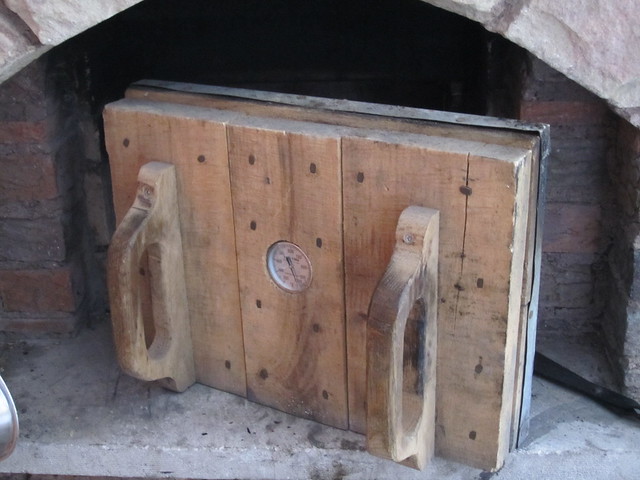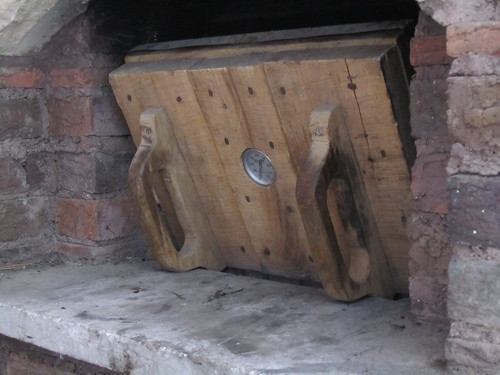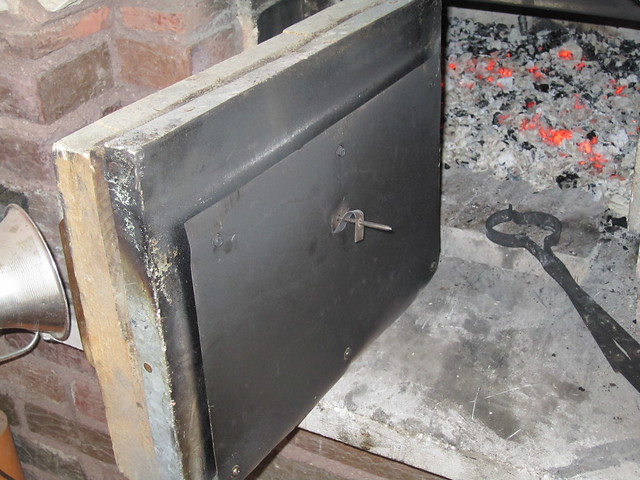This forum has been a bit slow lately, and since I've been meaning to post this for a while now, here's something for the cause. While I was firing for this week's batch (a small batch of basic baguettes and some roasted poblano peppers this week), I took a few pics of my oven door. The question of how to make a door comes up pretty often, and this is how I solved it for my own oven.
I made this door from white pine from a tree that was cut down in my yard. I milled a bunch of the wood up to use for furniture, etc, but I used one piece for this door. It's two layers of 1-1/2" pine, layed up in alternating directions -- the outer boards run vertical, the inner ones run horizontal. The two layers are held together with some cut nails, just 'cause I like the way they look -- kinda rustic. The handles are cut from 5/4" white oak and screwed on with 3" stainless steel deck screws. Note that the bottoms of the handles rest on the deck for added stability. These also do double duty -- they just fit in the ash dump, allowing me to prop the door open at an angle like a kitchen oven door. (I'd like to say I planned that, but it was purely fortuitous.) In the center, I countersunk a Big Green Egg accessory thermometer -- it registers from 200 -1,000 degrees. It's probe is about 6" long, so it extends well into the oven on the back side of the door. It's about 3 years old now, and not showing any signs of heat damage.

Here's how it looks when it's tilted. I sometimes use this "feature" when I want to allow some extra air into the oven when I have a smoking fire going. You can see here how the bottoms of the handles fit into the ash dump slot to hold the door at this angle.

Here's a shot of the business side of the door. The oven side is clad with galvanized steel left over from some HVAC work, bent to fit the door snugly and fastened along all sides with copper nails (roofing job leftovers). After using it this way a few times, I noticed that the wood was still getting too hot, so I added another layer of galvanized sheet, just exactly the same size as the inner door opening. (The door itself overlaps the masonry by about 3/4" at each side, and about 2" at the top, for a pretty tight seal.) With this cladding and shielding, I don't have to worry about keeping the wood wet like some do. I can use the door even when there's a small fire working off to one side, but not a big one (tho' I don't know why I'd want to use the door with a big fire anyway.) I often keep a bit of a fire going with the door on, cracked open just a bit, when I want to smoke a chicken, turkey or pork butt.

The inner heat sheild is held away from the door about 3/4" by some short lengths of 1/2" copper pipe (more leftovers) and is held on by more stainess steel deck screws driven through the heat shield, through the center of the pipe standoffs, through the door cladding and into the wood. I used stainless because it's a relatively poor conductor of heat and it helps keep the hot screws from scorching the wood where they enter it. You can also see the thermometer probe where it penetrates throught the door, the cladding and heat shield.
I don't use the thermometer much for bread baking -- I use masonry temps for that. But it does come in handy for other roasting and baking. Helps a bit with gauging timing of things that take a while to bake (e.g., turkeys) since the oven temps are continually falling if the fire's out. It also helps making sure the temps aren't rising too much if there's a smokinig fire going.
I'm planning some day to see if I can't add a gasket from a wood stove door to the perimeter just to improve the seal a bit.
ClimbHi
Pittsburgh, PA
Wow. I'm just building my oven now and am dreaming of how to have a door..period. Yours is awesome!
Hey ClimbHi, I have had your door stuck in my mind since January when you wrote this post. I was going to send you a private message, but figured maybe others would like to be reminded of this post AND get more information on it. So a few questions if I may.
How is the door holding up? I believe you had said 3 years in use at the time of the post, hopefully all is ok.
Did you have concerns using the galvanized sheet metal??? In other forums and perhaps this one as well, I had seen dire warning against using galvanized anything.
The nails you used, are they insulated enough from the fireside so as not to whick away your heat?
And finally so as not to over stay my welcome the sheet metal that you used to help reduce the heat that was cut to the door size. How is that attached to the door, it looks like you have some space between the 2 pieces of metal.
Thanks for your time, and know that I am goingt o steal this idea as the time has come to have a door.
Ever since I saw ClimbHi's door, I've wanted to have mine just like his! He has been so kind as to give me helpful information on how to build it. We had a guy in town make the metal part. My dad is going to put some of that rope lining stuff they use on stoves to close the gap "just" that much more.
It's a pretty tight fit!
We filled the gap with leftover Foamglas insulation wrapped in foil, leaving room for the thermometer to go all the way through.
This is the front of the door. Made out of oak.
NOT A LIGHT DOOR!
This is how it looks in the oven. I don't have an ash drop so I can't do the "tilted" thing, but maybe I can figure something else out! :)
ClimbHi, thanks for all your help with the door! I love it, can't wait to put the thermometer in and give it a whirl! :)
I appreciate all the questions you helped me with in building my oven and my door! :)
I hope many people will benifit from what you have done, just like me! :)
Thanks!!!
Faith
The door is holding up fine. Other than some patina from years of use, it's still in good shape.
I have no concerns with the galvanized -- the door is only used when the temps are relatively low (i.e., not when there is a blazing fire going), so it never really gets hot enough to be an issue. There are no signes of the coating deteriorating. Of course, no food ever touches it, so no worries about any transfer from contact. If you're worried, you could use stainless steel tho'. In fact, probably better from a lower heat transfer standpoint -- just harder to obtain and work with.
The nails holding the sheet metal base layer on to the door are driven into the side of the door where the metal wraps around, not the inside face. So there isn't really any concern with wicking heat since the nails are always outside the oven.
As for the heat shield, take a close look at my earlier post. The heat shield is spaced away from the door face by short lenghts of 1/2" copper pipe. Stainless steel screws are driven through the heat shield, through the pipe ID, and into the door. I use stainless since it conducts heat more slowly than regular steel. (I had tried using standard steel screws on an earlier attempt, and I found that they conducted enough heat to scorch/carbonize the wood of the door.)
ClimbHi
Pittsburgh, PA
Yeeeeshhhh I went back and looked at your post and saw that you did indeed explain how you attached the heat shield. Sometimes I wonder about myself.
Thanks for the response, I appreciate it. Hopefully tis week I can get my door going.
your door is really a nice design.
Frankie G
www.fgpizza.com
I really enjoy your site. I've sent more than a few shoppers your way!
ClimbHi
Pittsburgh, PA
Thank you ClimbHi. We really appreciate it.
We do this business for our daughter's education and every little bit helps.
I am in the process of rebuilding my door. My current door is too heavy and sometimes precarious. You have been an inspiration in my new design. Thank you.
Frankie G
www.FGpizza.com
Here is my door. It is all 10 gauge steel, 2" thick with a 2" ceramic blanket painted with 1200° F high temp paint. Door weighs 30 lbs which is about the maximum weight I would want for a door. No thermal warpage and I have a 2° slant in the bottom of the door so it leans into the oven. At 600° F the outside of the door is 200° F . I'm going to make a second door to go over the metal door to help hold in more heat. Thinking of a plywood front, 4" of ceramic blanket with spaces were it will cover the handles and encasing that with metal flashing. I was tired of waking up to a pile of ash where my door was so I went with a design that will never burn up. It's not perfect but five days later, in Toledo OH temperatures, the oven temperature is still 200° F in my Tuscan oven.